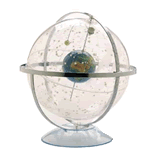BACKGROUND:
Stars are balls of gas that emit energy created by
fusion, a nuclear reaction within the star. There are many sizes and
brightness of stars, ranging from super hot, blue-white stars (over
20,000EK) to cool red stars (3,000EK). Our Sun is a medium yellow star,
towards the small and cool end of the spectrum. Current theory suggests that
stars are born in nebulae, which are interstellar gas clouds. This is
happening today. An example is the Orion Nebula (in the sword or bow of the
Orion the Hunter constellation). Stars also die. Older stars types include
red giants and supergiants.
Constellations are apparent associations of stars and
galaxies, as seen from Earth. In reality, these objects are very far away
from each other. The stars that make up the constellations are all within
our own Milky Way galaxy. The galaxies can be much further away; because of
their distance, they appear as points of light to the naked eye.
Constellations were very important to early people.
They allowed them to find directions during the night, which helped them
navigate on land and at sea. The yearly changes in the constellations also
revealed to early farmers when spring and summer were approaching. This was
more accurate than watching the Sun rise and set every morning.
One special group of constellations is called the
Zodiac. The Zodiac constellations occur in a band that is parallel to the
Earthís orbit or called the ecliptic. The ecliptic is the band between the
Sunís highest point (summer) and the lowest point (winter) in the sky. The
stars in the Zodiac constellations move very slowly compared to the Sun and
the rest of the Solar System. They seem to be fixed in the sky.
As the Earth moves around the Sun, the Sun comes
between the Earth and each of the Zodiac constellations. Because the Earth
always revolves around the Sun in the same direction, the Sun crosses in
front of the Zodiac constellations in the same order every year. This means
that if you can recognize the Zodiac constellations, you can tell what time
of year it is. They work like a calender.
This sky calender and the Zodiac constellations we
identify today were first used by Babylonian astronomers about 2500 years
ago. Babylon was a Middle Eastern culture that is well-known for its
discoveries in astronomy and other sciences. The Babylonians used the Zodiac
constellations to tell when spring was coming. This allowed them to tell
when it was time to plant crops and to prepare for changes in the weather.
Ancient people who studied the constellations were
called astrologists. Today astrologists are pseudo scientists who try and
predict the future using the signs of the Zodiac. Astronomy is the study of
the origin, movement, and behavior of stars and all other components in the
Universe. Astronomy is a science, based on repeated observations of the
stars, and accurately predicts their motions and behavior. Some people
confuse astronomy with astrology. There is no evidence that astrological
predictions are accurate.
Today, we use the ancient constellations to help us
locate different sectors of the Universe. Astronomers have divided the
celestial globe into 88 constellation, which are listed on a separate sheet.
PROCEDURE:
-
 Use the Celestial Globe to illustrate how we see the Universe from
Earth. The Earth is in the center and you can easily show that if you
live in the United State, the sky you see, is different than the sky you
see if you lived in Australia. Compare this to the Inflatable Celestial
Globe, which only illustrates the "clear" portion of the
Celestial Globe.
Use the Celestial Globe to illustrate how we see the Universe from
Earth. The Earth is in the center and you can easily show that if you
live in the United State, the sky you see, is different than the sky you
see if you lived in Australia. Compare this to the Inflatable Celestial
Globe, which only illustrates the "clear" portion of the
Celestial Globe.
-
Discuss the components of the Universe by going over the vocabulary.
Emphasize that the Universe includes galaxies, stars, planets, and
anything else in space. Explain to the students that there is much that
we do not know about stars. If some students are interested in the
Universe, recommend that they consult the Internet, books, or magazines
on the subject. New information on the Universe is updated, especially
as new equipment is developed for space exploration.
-
Give each student a Constellation Placemat and instruct them to try
and find different constellations that you can find on the "88
Constellation Chart."
-
Review the constellations of the Zodiac by using the worksheet and
compare them with the 88 constellations used by astronomers. You may
want students to write a story about one of them.
-
Ask the students if they know the difference between astrology and
astronomy. You may want to use the following graphs to help students
determine the difference.